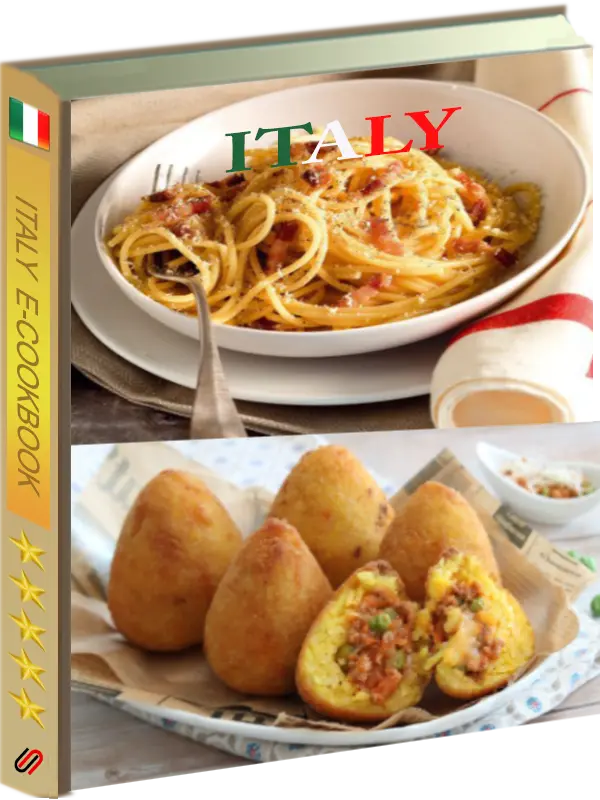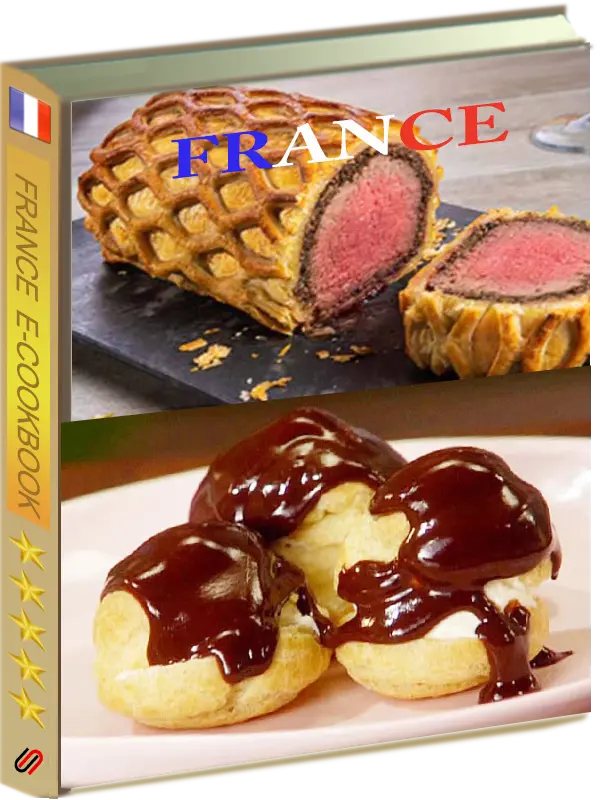japan Is My Kitchen
JAPAN Breakfast Appetizers & Soups
liquid Measures
Weight & temperature Measures
non-liquid ingredients
Top 5 countries
Last Page
Avocado Sashimi
Coconut tofu fingers with spicy plum sauce
Edamame hummus with spiced pita chips
Hokkaido brioche
Snow Pea fennel and Enoki Mushroom Salad
Tamagoyaki - japanese rolled omelette
Tuna tartare with grapefruit vinaigrette and sorbet
JAPAN Main Dishes
Black cod sushi burrito
Crispy fried tofu katsu style
Crispy tofu tacos
Oriental salmon rice muffins
Panko-crusted salmon
Ramen burger
Sesame tofu fingers
Spicy edamame burgers
Teriyaki tofu burger
Tofu bites
Tofu patties
Vegan salmon
JAPAN Desserts
Crispy fried tofu katsu style
Crispy tofu tacos
Oriental salmon rice muffins
Panko-crusted salmon
Ramen burger
Sesame tofu fingers
Spicy edamame burgers
Teriyaki tofu burger
Tofu bites
Tofu patties
Vegan salmon
Weight & temperature Measures
non-liquid ingredients
Top 5 countries
Last Page
Traditional Japanese Dishes
Sushi
Sushi is one of the best known Japanese foods around the world.
Sushi usually refers to a dish of pressed vinegared rice with a piece of raw fish or shellfish, called a neta, on top. Sushi is generally eaten with soy sauce and wasabi.
Sashimi
Sashimi is is similar to sushi but without the rice, sashimi is raw fish sliced into easy-to-eat pieces. The high-quality of the fish caught in all regions of Japan makes it a great choice no matter if you are visiting Tokyo, Kyoto, or Hokkaido.
Just like sushi, diners can enjoy dozens of varieties of sashimi. Some of the most common and popular varieties are maguro and other tuna varieties, salmon, mackerel, and sea bream. You can also try clams, uni, or sea urchin, and salmon roe. Sashimi vs. Nigiri: What Are the Differences?
Sashimi and nigiri are both Japanese preparations of raw fish and seafood, but there are a few differences.
Serving: Sashimi is simply served as slices of raw fish, whereas nigiri is sliced raw fish served on top of a mount or ball of vinegared rice.
Classification: Since nigiri is served with vinegared rice, it is considered a type of sushi. Sashimi is a stand-alone dish, though sashimi (raw fish) is incorporated into many types of sushi.
Ingredients: Sashimi is always raw, whether it’s fish, seafood or another protein. Nigiri can include raw fish as well as cooked components, such as unagi (eel), tamago-yaki (cooked egg) or vegetables.
Portion: Sashimi includes multiple slices of one type of fish, whereas nigiri is a one-bite serving.
Presentation: Sashimi is served with seasonal garnishes and colors and textures that highlight the fish and add dimension to the plate. Nigiri is typically served without any additional garnishes or accompaniments.
Tempura
Tempura is a dish involving ingredients like seafood, meat, and vegetables covered in batter and deep-fried in oil. Tempura is generally dipped in a special sauce called tentsuyu before eating. Tentsuyu is a sauce made of broth from kombu or dried bonito, mirin, and soy sauce mixed at a ratio of 4:1:1 and cooked. You can add ginger or grated radish to your liking for a more refreshing taste. Soba - Buckwheat Noodles
Soba is a noodle dish made from buckwheat flour with water and flour, thinly spread and cut into noodles with widths of 1cm-2cm. After boiling the noodles in hot water, it is eaten dipped in cold soup, or by pouring hot soup over it. The sobatsuyu - sobajiru, made from kombu or dried bonito broth with seasonings like soy sauce and mirin, is crucial for having a delicious soba experience. Udon - Hearty Wheat Noodles
Udon is a unique dish known for its thick noodles. Udon is also a well-known traditional Japanese dish. The dough is made from flour and salt water that is well-kneaded and cut into noodles. After being boiled in hot water, much like soba, it is eaten in seafood broth soup, or by pouring soup and toppings like tempura on top of it. There is no one designated way to eat udon.
Onigiri - Rice Balls
Onigiri, also called omusubi, may just look like plain rice, but they often have a savory filling inside and are wrapped with a salty sheet of nori seaweed. They are made in bento lunches by families and often seen sold in convenience stores and supermarkets. This is a classic choice for a snack or light meal. Common flavors for onigiri include kelp, pickled plum (umeboshi), salmon, and bonito flakes. There are also many other flavors.
Yakitori - Grilled Chicken Skewers
Yakitori is a popular food where chicken is cut into small pieces, then placed on bamboo skewers and grilled. It is often found on the menus of izakaya and casual restaurants, making it a good option for a night out in Japan with friends. It is especially delicious when paired with alcohol. Also, if you go to a Japanese festival, there is a good chance that food stalls will be selling this classic dish.
Sukiyaki - Japanese Hot Pot
Sukiyaki is a one-pot dish cooked in a shallow iron pan, traditionally enjoyed in the fall and winter in Japan. It became popular in Japan around the 19th century. Made both in homes and available on menus at restaurants, it is a dish you will want to try when in Japan.
Sukiyaki is made with several different ingredients, like thin slices of beef, green onion, mushroom, tofu, and noodles. Diners prepare the dish themselves by boiling the ingredients in the pot. After the ingredients are cooked thoroughly, to eat sukiyaki in its conventional way, dip the meat or vegetable into a bowl of beaten egg. Note that there are regional differences in how sukiyaki is made across Japan, namely between the Kanto and Kansai regions. In Kansai, the meat is grilled before being boiled in the potOden - Simmered Ingredients
Oden is a dish of various ingredients simmered in broth. The ingredients are meant to bring out the flavor of the dashi (consisting usually of a mixture of seafood and kelp) and have a savory, salty taste. Oden has been eaten for a long time in Japan and is thought to have been first made during the Muromachi period (1336 – 1573).
Mild-tasting vegetables, tofu, and fish are common ingredients in oden. Daikon radish, a thick root vegetable, can be found at most shops with oden. Another popular choice is ganmodoki, a hearty mixture of tofu and vegetables made into a circular shape.
Miso Soup
Miso soup is another famous Japanese food, renowned for its great taste and health benefits. This soup is conventionally drunk accompanied by other side and main dishes. A traditional Japanese diet generally includes drinking miso soup daily.
Miso soup is made simply, with the fermented miso base, which has a flavorful taste full of depth, added to Japanese dashi (conventionally mixture of bonito and kelp). There are hundreds of regional varieties on miso soup, from simple soups with just seaweed and tofu to ones with crab and a variety of vegetables.
Miso paste itself comes in different types, from white, which has a sweet flavor, to a darker, saltier red. Be sure to enjoy authentic miso soup when you are in Japan. It is served at most Japanese restaurants in all price ranges; you will find miso soup with teishoku set meals as well as high-end kaiseki cuisine, and everything in between.
Ramen
(ラーメン, Shina Soba, Chūka Soba, Ramyeon, 라면)
Ramen is a noodle soup that first appeared in Japan in 1910, when Chinese cooks combined the noodles with a salty broth. These curly noodles were of bright yellow color and more elastic than the Japanese noodles prepared at the time – the dough was kneaded with a sodium carbonate-infused mineral water called kansui.
In 1958, its name was derived from the pronunciation of the Chinese word lamian (pulled noodles), and that same year, Nissin Foods produced the first-ever instant version of noodles with a chicken-flavored broth called Chickin Ramen.
Shortly after, the dish started to be exported around the world. Ramen should be cooked al dente and eaten quickly while it is still hot. It is not recommended to leave the noodles sitting in the broth for too long, as they tend to become too soft and mushy.
The dish can be either kotteri (rich) or assari/paitan (light), depending on the opaqueness and the heaviness of the broth which is usually made using animal bones or dried seafood mixed with onions, garlic, ginger, leeks, and mushrooms.
Two most famous types of ramen are ramen of Kyushu, prepared with a boiled pork bone broth called tonkotsu, and ramen of Hokkaido, made with a traditional seasoning called red miso.
Sushi
Sushi is one of the best known Japanese foods around the world.
Sushi usually refers to a dish of pressed vinegared rice with a piece of raw fish or shellfish, called a neta, on top. Sushi is generally eaten with soy sauce and wasabi.
Sashimi
Sashimi is is similar to sushi but without the rice, sashimi is raw fish sliced into easy-to-eat pieces. The high-quality of the fish caught in all regions of Japan makes it a great choice no matter if you are visiting Tokyo, Kyoto, or Hokkaido.
Just like sushi, diners can enjoy dozens of varieties of sashimi. Some of the most common and popular varieties are maguro and other tuna varieties, salmon, mackerel, and sea bream. You can also try clams, uni, or sea urchin, and salmon roe. Sashimi vs. Nigiri: What Are the Differences?
Sashimi and nigiri are both Japanese preparations of raw fish and seafood, but there are a few differences.
Serving: Sashimi is simply served as slices of raw fish, whereas nigiri is sliced raw fish served on top of a mount or ball of vinegared rice.
Classification: Since nigiri is served with vinegared rice, it is considered a type of sushi. Sashimi is a stand-alone dish, though sashimi (raw fish) is incorporated into many types of sushi.
Ingredients: Sashimi is always raw, whether it’s fish, seafood or another protein. Nigiri can include raw fish as well as cooked components, such as unagi (eel), tamago-yaki (cooked egg) or vegetables.
Portion: Sashimi includes multiple slices of one type of fish, whereas nigiri is a one-bite serving.
Presentation: Sashimi is served with seasonal garnishes and colors and textures that highlight the fish and add dimension to the plate. Nigiri is typically served without any additional garnishes or accompaniments.
Tempura
Tempura is a dish involving ingredients like seafood, meat, and vegetables covered in batter and deep-fried in oil. Tempura is generally dipped in a special sauce called tentsuyu before eating. Tentsuyu is a sauce made of broth from kombu or dried bonito, mirin, and soy sauce mixed at a ratio of 4:1:1 and cooked. You can add ginger or grated radish to your liking for a more refreshing taste. Soba - Buckwheat Noodles
Soba is a noodle dish made from buckwheat flour with water and flour, thinly spread and cut into noodles with widths of 1cm-2cm. After boiling the noodles in hot water, it is eaten dipped in cold soup, or by pouring hot soup over it. The sobatsuyu - sobajiru, made from kombu or dried bonito broth with seasonings like soy sauce and mirin, is crucial for having a delicious soba experience. Udon - Hearty Wheat Noodles
Udon is a unique dish known for its thick noodles. Udon is also a well-known traditional Japanese dish. The dough is made from flour and salt water that is well-kneaded and cut into noodles. After being boiled in hot water, much like soba, it is eaten in seafood broth soup, or by pouring soup and toppings like tempura on top of it. There is no one designated way to eat udon.
Onigiri - Rice Balls
Onigiri, also called omusubi, may just look like plain rice, but they often have a savory filling inside and are wrapped with a salty sheet of nori seaweed. They are made in bento lunches by families and often seen sold in convenience stores and supermarkets. This is a classic choice for a snack or light meal. Common flavors for onigiri include kelp, pickled plum (umeboshi), salmon, and bonito flakes. There are also many other flavors.
Yakitori - Grilled Chicken Skewers
Yakitori is a popular food where chicken is cut into small pieces, then placed on bamboo skewers and grilled. It is often found on the menus of izakaya and casual restaurants, making it a good option for a night out in Japan with friends. It is especially delicious when paired with alcohol. Also, if you go to a Japanese festival, there is a good chance that food stalls will be selling this classic dish.
Sukiyaki - Japanese Hot Pot
Sukiyaki is a one-pot dish cooked in a shallow iron pan, traditionally enjoyed in the fall and winter in Japan. It became popular in Japan around the 19th century. Made both in homes and available on menus at restaurants, it is a dish you will want to try when in Japan.
Sukiyaki is made with several different ingredients, like thin slices of beef, green onion, mushroom, tofu, and noodles. Diners prepare the dish themselves by boiling the ingredients in the pot. After the ingredients are cooked thoroughly, to eat sukiyaki in its conventional way, dip the meat or vegetable into a bowl of beaten egg. Note that there are regional differences in how sukiyaki is made across Japan, namely between the Kanto and Kansai regions. In Kansai, the meat is grilled before being boiled in the potOden - Simmered Ingredients
Oden is a dish of various ingredients simmered in broth. The ingredients are meant to bring out the flavor of the dashi (consisting usually of a mixture of seafood and kelp) and have a savory, salty taste. Oden has been eaten for a long time in Japan and is thought to have been first made during the Muromachi period (1336 – 1573).
Mild-tasting vegetables, tofu, and fish are common ingredients in oden. Daikon radish, a thick root vegetable, can be found at most shops with oden. Another popular choice is ganmodoki, a hearty mixture of tofu and vegetables made into a circular shape.
Miso Soup
Miso soup is another famous Japanese food, renowned for its great taste and health benefits. This soup is conventionally drunk accompanied by other side and main dishes. A traditional Japanese diet generally includes drinking miso soup daily.
Miso soup is made simply, with the fermented miso base, which has a flavorful taste full of depth, added to Japanese dashi (conventionally mixture of bonito and kelp). There are hundreds of regional varieties on miso soup, from simple soups with just seaweed and tofu to ones with crab and a variety of vegetables.
Miso paste itself comes in different types, from white, which has a sweet flavor, to a darker, saltier red. Be sure to enjoy authentic miso soup when you are in Japan. It is served at most Japanese restaurants in all price ranges; you will find miso soup with teishoku set meals as well as high-end kaiseki cuisine, and everything in between.
Ramen
(ラーメン, Shina Soba, Chūka Soba, Ramyeon, 라면)
Ramen is a noodle soup that first appeared in Japan in 1910, when Chinese cooks combined the noodles with a salty broth. These curly noodles were of bright yellow color and more elastic than the Japanese noodles prepared at the time – the dough was kneaded with a sodium carbonate-infused mineral water called kansui.
In 1958, its name was derived from the pronunciation of the Chinese word lamian (pulled noodles), and that same year, Nissin Foods produced the first-ever instant version of noodles with a chicken-flavored broth called Chickin Ramen.
Shortly after, the dish started to be exported around the world. Ramen should be cooked al dente and eaten quickly while it is still hot. It is not recommended to leave the noodles sitting in the broth for too long, as they tend to become too soft and mushy.
The dish can be either kotteri (rich) or assari/paitan (light), depending on the opaqueness and the heaviness of the broth which is usually made using animal bones or dried seafood mixed with onions, garlic, ginger, leeks, and mushrooms.
Two most famous types of ramen are ramen of Kyushu, prepared with a boiled pork bone broth called tonkotsu, and ramen of Hokkaido, made with a traditional seasoning called red miso.
Appetizer Avocado Sashimi 

Shichimi togarashi (also called nanami togarashi) is a spice blend that consists of 7 ingredients.
A blend may contain ground red chili pepper, ground sichuan pepper, roasted orange peel, black sesame seeds, white sesame seeds, hemp seeds, ground ginger, nori or aonori, poppy seeds, yuzu peel, rape seed, or shiso, depending on the maker. It’s wonderful sprinkled on everything from chicken or fish, to soup or steamed vegetables.
Serves: 2
1/2 fresh lemon
shichimi togarashi
wasabi paste
soy sauce
A blend may contain ground red chili pepper, ground sichuan pepper, roasted orange peel, black sesame seeds, white sesame seeds, hemp seeds, ground ginger, nori or aonori, poppy seeds, yuzu peel, rape seed, or shiso, depending on the maker. It’s wonderful sprinkled on everything from chicken or fish, to soup or steamed vegetables.
Serves: 2
Preparation time: 10 minutes
1 ripe avocado1/2 fresh lemon
shichimi togarashi
wasabi paste
soy sauce
Peel the avocado and cut into slices.
Squeeze lemon juice over the slices. Sprinkle with shichimi togarashi and serve with wasabi and soy sauce.
Squeeze lemon juice over the slices. Sprinkle with shichimi togarashi and serve with wasabi and soy sauce.
Appetizer Coconut tofu fingers with spicy plum sauce 

Tofu’s firm texture is perfect for the crispy, nutty coating, and it’s even better dunked into our spicy three-ingredient plum sauce. It’s easy, affordable and vegetarian!
Serves: 4
1 egg
2 tbsp (30 mL) all-purpose flour
1 tbsp (15 mL) cornstarch
1 tsp (5 mL) water
1 cup (250 mL) unsweetened medium-shred coconut, or more as needed
Canola oil for frying
Salt to taste
1/2 cup (125 mL) plum sauce
1 tsp (5 mL) sriracha sauce
1 tsp (5 mL) mayonnaise
Serves: 4
Preparation time:15 minutes
Cooking time:2 minutes
1 pkg (350 g) extra-firm tofu, drained1 egg
2 tbsp (30 mL) all-purpose flour
1 tbsp (15 mL) cornstarch
1 tsp (5 mL) water
1 cup (250 mL) unsweetened medium-shred coconut, or more as needed
Canola oil for frying
Salt to taste
1/2 cup (125 mL) plum sauce
1 tsp (5 mL) sriracha sauce
1 tsp (5 mL) mayonnaise
1. Cut tofu lengthwise into four even slabs. Cut each slab in half lengthwise and again crosswise. You will have 16 tofu fingers. Place on a baking sheet lined with a clean kitchen towel or paper towel. Drain for 10 minutes, turning occasionally.
2. In a small shallow baking dish, use a fork to stir together egg, flour, cornstarch and 1 tsp (5 mL) water until smooth. Place coconut in a separate shallow bowl.
3. Working two at a time, gently coat tofu with egg mixture, let excess drip off and gently dredge in coconut. Place on baking sheet.
4. In a large frying pan or skillet, add enough oil to come up sides by 1/2 inch (1 cm). Place over medium heat. Working in two batches, carefully place tofu fingers in hot oil. Cook until golden brown, about 30 seconds per side. (Coconut burns easily, so watch carefully.) Transfer to a cooling rack set over a baking sheet. Season with salt.
5. Whisk together plum sauce, sriracha and mayo in a small bowl and serve with tofu fingers.
2. In a small shallow baking dish, use a fork to stir together egg, flour, cornstarch and 1 tsp (5 mL) water until smooth. Place coconut in a separate shallow bowl.
3. Working two at a time, gently coat tofu with egg mixture, let excess drip off and gently dredge in coconut. Place on baking sheet.
4. In a large frying pan or skillet, add enough oil to come up sides by 1/2 inch (1 cm). Place over medium heat. Working in two batches, carefully place tofu fingers in hot oil. Cook until golden brown, about 30 seconds per side. (Coconut burns easily, so watch carefully.) Transfer to a cooling rack set over a baking sheet. Season with salt.
5. Whisk together plum sauce, sriracha and mayo in a small bowl and serve with tofu fingers.
Appetizer Edamame hummus with spiced pita chips 
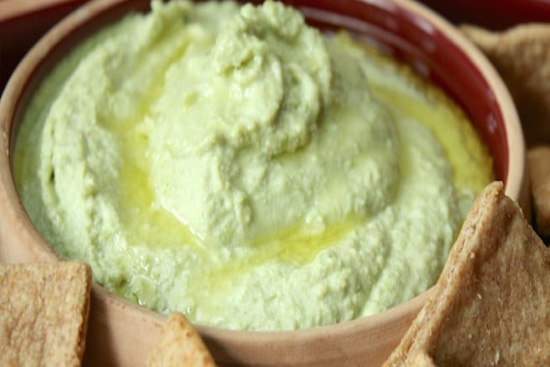
This fresh green, creamy dip, excerpted from the cookbook The Food You Crave , has all the classic hummus flavors of garlic, cumin, and lemon. with a big citrus punch. Its smooth texture make it the perfect companion to the bold spicy shards of pita.
Hummus can be refrigerated in an airtight container for up to 3 days.
Serves: 10
1 cup silken tofu, drained
1/2 tsp. salt, plus more to taste
Pinch of white pepper, plus more to taste
1-1/2 tsp. ground cumin, plus more for garnish
3 cloves garlic, minced (about 1 Tbs.)
1/4 cup olive oil
1/3 cup fresh lemon juice, plus more to taste
See Recipe for Spiced pita chips
Serves: 10
Preparation time:10 minutes
2 cups frozen shelled edamame, cooked according to package directions1 cup silken tofu, drained
1/2 tsp. salt, plus more to taste
Pinch of white pepper, plus more to taste
1-1/2 tsp. ground cumin, plus more for garnish
3 cloves garlic, minced (about 1 Tbs.)
1/4 cup olive oil
1/3 cup fresh lemon juice, plus more to taste
See Recipe for Spiced pita chips
Set 1 tablespoon of the edamame aside for a garnish.
Place the rest, along with the tofu, salt, pepper, cumin, garlic, oil and lemon juice, in a food processor and process until very smooth, about 2 minutes. Taste and adjust the seasoning with more salt, pepper, or lemon juice, if desired.
Transfer the hummus to a serving bowl and garnish with the reserved edamame and a sprinkle of cumin. Serve with the spiced pita chips
.
Place the rest, along with the tofu, salt, pepper, cumin, garlic, oil and lemon juice, in a food processor and process until very smooth, about 2 minutes. Taste and adjust the seasoning with more salt, pepper, or lemon juice, if desired.
Transfer the hummus to a serving bowl and garnish with the reserved edamame and a sprinkle of cumin. Serve with the spiced pita chips
.
Appetizer Hokkaido brioche 
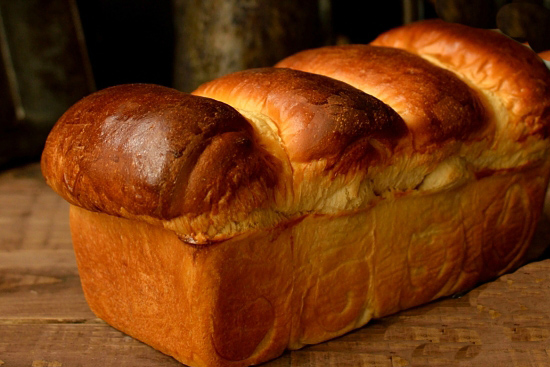
Hokkaido milk bread is quite simply the fluffiest, softest, lightest, most pillowy cloud of deliciousness thanks to a simple technique involving a roux starter known as tangzhong.
Serves: 8
• 20 g (3/4 oz) strong white bread flour
• 75ml (6 tbsp) water
• 1 tbsp whole milk
Dough
• 350 g (scant 3 cups) strong white bread flour
• 7 g (2 tsp) fast action yeast
• 1 tsp salt
• 60 g (scant 1/3 cup) sugar
• 1 tbsp milk powder
• 1 egg
• 120 ml (1/2 cup whole milk
• 30 g (2 tbsp) softened butter
• 1 egg beaten with a splash of milk, to glaze
Serves: 8
Preparation time:2 hours
Cooking time:30 minutes
Tangzhong• 20 g (3/4 oz) strong white bread flour
• 75ml (6 tbsp) water
• 1 tbsp whole milk
Dough
• 350 g (scant 3 cups) strong white bread flour
• 7 g (2 tsp) fast action yeast
• 1 tsp salt
• 60 g (scant 1/3 cup) sugar
• 1 tbsp milk powder
• 1 egg
• 120 ml (1/2 cup whole milk
• 30 g (2 tbsp) softened butter
• 1 egg beaten with a splash of milk, to glaze
To make the tangzhong:
Combine all of the ingredients in a small saucepan, and whisk until no lumps remain.
Place the saucepan over low heat, and cook the mixture, whisking constantly, until thick and the whisk leaves lines on the bottom of the pan, about 3 to 5 minutes.
Transfer the tangzhong to a small mixing bowl or measuring cup and let it cool to room temperature.
To make the dough
1. Place the flour in a large bowl (or the bowl of your stand mixer, fitted with a dough hook) and add the yeast to one side, the salt, sugar and milk powder to the other (if the salt is added on top of the yeast it can kill it), stir to combine.
2. Whisk together the cooled tangzhong, egg and milk and add it to the dry ingredients. Mix everything together until it forms a soft, shaggy dough. If you are kneading by hand, turn the dough out onto a worktop and knead for 5-10 minutes until it starts to feel smooth and a little less sticky (it will still be very sticky), add no more than a spoonful of flour while you are kneading, the dough is meant to be sticky! The best way to knead a wet dough by hand is to stretch it up away from the worktop (it will stick), then slap it back down, make sure that you pull from a different section each time and keep a dough scraper handy. If you are using a stand mixer, mix for 5 minutes or so until the dough is smooth.
3. Add the butter and mix until it is fully incorporated, continue to knead until the dough is very elastic and begins to come away from the worktop (or sides of the stand mixer bowl) cleanly. It should pass the windowpane test - stretch the dough with your hands, you should be able to stretch it to a very thin, almost transparent membrane without it tearing. This can take up to 20 minutes of kneading, especially by hand.
4. Place the dough in a lightly oiled bowl and cover with clingfilm, leave to rise for 1-2 hours until well doubled in size. Alternatively, place it in the fridge to rise overnight. If you refrigerate it, the following day let it come up to room temperature for about half an hour before continuing.
5. Line an 8.5x4.5in (or thereabouts) loaf tin with greaseproof paper. Once the dough has risen, punch it down and fold it in on itself a couple of times. Turn out onto a lightly floured surface, divide it in to four equal pieces and roll each one into a ball.
6. Roll each ball out into a long oval, fold one third of the oval over the middle (from the side, not the top), then the other third over the top to form a long, narrow packet. Roll over the seam to flatten it, then roll it up from one end to make a fat sausage. Repeat with the other balls of dough then arrange them in the loaf tin, seam side down.
7. Loosely cover with oiled clingfilm and leave to rise until at least doubled in size, this can take 1-2 hours (mine took nearly 2). If you press the dough gently with a finger the indentation should spring back slowly but remain visible. If it springs back quickly it needs to proof for a little longer. Preheat the oven while the dough is rising to 180C/350F/gas mark 4.
8. Brush the top of the dough with some of the beaten egg then bake on the lower middle shelf of the oven for 30-40 minutes until well risen and the bread sounds hollow when tapped on the bottom, the internal temperature should reach 94C/200F on a probe thermometer. Cover the bread with foil partway through baking if it starts to get too dark.
9. Transfer to a wire rack and leave to cool completely before slicing.
Combine all of the ingredients in a small saucepan, and whisk until no lumps remain.
Place the saucepan over low heat, and cook the mixture, whisking constantly, until thick and the whisk leaves lines on the bottom of the pan, about 3 to 5 minutes.
Transfer the tangzhong to a small mixing bowl or measuring cup and let it cool to room temperature.
To make the dough
1. Place the flour in a large bowl (or the bowl of your stand mixer, fitted with a dough hook) and add the yeast to one side, the salt, sugar and milk powder to the other (if the salt is added on top of the yeast it can kill it), stir to combine.
2. Whisk together the cooled tangzhong, egg and milk and add it to the dry ingredients. Mix everything together until it forms a soft, shaggy dough. If you are kneading by hand, turn the dough out onto a worktop and knead for 5-10 minutes until it starts to feel smooth and a little less sticky (it will still be very sticky), add no more than a spoonful of flour while you are kneading, the dough is meant to be sticky! The best way to knead a wet dough by hand is to stretch it up away from the worktop (it will stick), then slap it back down, make sure that you pull from a different section each time and keep a dough scraper handy. If you are using a stand mixer, mix for 5 minutes or so until the dough is smooth.
3. Add the butter and mix until it is fully incorporated, continue to knead until the dough is very elastic and begins to come away from the worktop (or sides of the stand mixer bowl) cleanly. It should pass the windowpane test - stretch the dough with your hands, you should be able to stretch it to a very thin, almost transparent membrane without it tearing. This can take up to 20 minutes of kneading, especially by hand.
4. Place the dough in a lightly oiled bowl and cover with clingfilm, leave to rise for 1-2 hours until well doubled in size. Alternatively, place it in the fridge to rise overnight. If you refrigerate it, the following day let it come up to room temperature for about half an hour before continuing.
5. Line an 8.5x4.5in (or thereabouts) loaf tin with greaseproof paper. Once the dough has risen, punch it down and fold it in on itself a couple of times. Turn out onto a lightly floured surface, divide it in to four equal pieces and roll each one into a ball.
6. Roll each ball out into a long oval, fold one third of the oval over the middle (from the side, not the top), then the other third over the top to form a long, narrow packet. Roll over the seam to flatten it, then roll it up from one end to make a fat sausage. Repeat with the other balls of dough then arrange them in the loaf tin, seam side down.
7. Loosely cover with oiled clingfilm and leave to rise until at least doubled in size, this can take 1-2 hours (mine took nearly 2). If you press the dough gently with a finger the indentation should spring back slowly but remain visible. If it springs back quickly it needs to proof for a little longer. Preheat the oven while the dough is rising to 180C/350F/gas mark 4.
8. Brush the top of the dough with some of the beaten egg then bake on the lower middle shelf of the oven for 30-40 minutes until well risen and the bread sounds hollow when tapped on the bottom, the internal temperature should reach 94C/200F on a probe thermometer. Cover the bread with foil partway through baking if it starts to get too dark.
9. Transfer to a wire rack and leave to cool completely before slicing.
Appetizer Snow Pea fennel and Enoki Mushroom Salad 
Serves: 4
Preparation time: 30 minutes
Cooking time:40 minutes
1/4 cup plus 2 tablespoons silken tofu2 teaspoons extra-virgin olive oil
1 1/2 teaspoons tamari or soy sauce
1 teaspoon unseasoned rice vinegar
1 teaspoon fresh lemon juice
1 teaspoon finely grated peeled fresh ginger
1/4 teaspoon Asian sesame oil
Salt
1 cup snow peas (3 ounces)
1 fennel bulb, sliced
1/4 cup cut chives (in 1-inch lengths)
2 ounces enoki mushrooms
2 tablespoons chopped chervil or flat-leaf parsley
2 tablespoons chopped basil
In a blender, puree the tofu with the olive oil, tamari, rice vinegar, lemon juice, ginger and sesame oil. Scrape the dressing into a bowl and season with salt.
In a small saucepan of salted boiling water, blanch the snow peas for 30 seconds. Drain and pat dry, then slice lengthwise into thin strips.
Steam the sliced fennel for 10-12 minutes. Drain and cool.
In a large bowl, toss the fennel with the snow peas, chives, enoki mushrooms, chervil and basil. Add the tofu dressing and toss again. Transfer to plates and serve.
MAKE AHEAD
The dressing can be refrigerated for up to 3 days. Stir the dressing before using.
NOTES
In a small saucepan of salted boiling water, blanch the snow peas for 30 seconds. Drain and pat dry, then slice lengthwise into thin strips.
Steam the sliced fennel for 10-12 minutes. Drain and cool.
In a large bowl, toss the fennel with the snow peas, chives, enoki mushrooms, chervil and basil. Add the tofu dressing and toss again. Transfer to plates and serve.
MAKE AHEAD
The dressing can be refrigerated for up to 3 days. Stir the dressing before using.
NOTES
Appetizer Tamagoyaki - japanese rolled omelette 
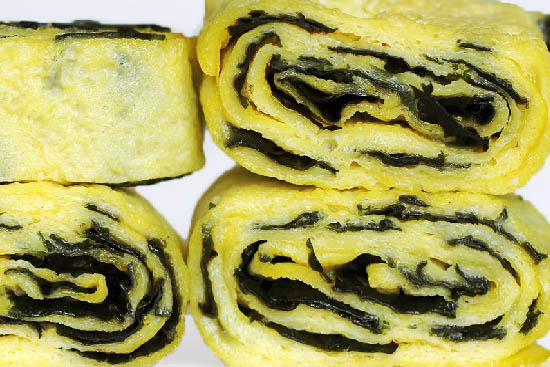
A recipe inspired by Just One Cookbook.com
Tamagoyaki (Japanese Rolled Omelette) 玉子焼き (卵焼き or 玉子焼き) is a Japanese rolled omelette, and it is commonly served as part of Japanese style breakfast or put in a bento (Japanese lunch box) as a side dishes.
What you may not know is that when dashi is added to the egg mixture, the dish is actually called Dashimaki Tamago. (出し巻き卵). Dashi is the Japanese stock made of kombu (edible kelp) and Katsuobushi (smoked bonito flakes), maki in Japanese means to roll, and tamago means eggs.
Serves: 6
2 Tbsp. cooking oil (vegetable or canola)
1½ sheet nori (optional)
1" (2.5 cm) green part of daikon radish (it's sweeter than white part)
Soy sauce
Seasonings
3 Tbsp. dashi (Use Kombu Dashi for vegetarian)
2 tsp. sugar
1 tsp. soy sauce
1 tsp. mirin
2 pinches of salt
Serves: 6
Preparation time:15 minutes
Cooking time:10 minutes
3 large eggs2 Tbsp. cooking oil (vegetable or canola)
1½ sheet nori (optional)
1" (2.5 cm) green part of daikon radish (it's sweeter than white part)
Soy sauce
Seasonings
3 Tbsp. dashi (Use Kombu Dashi for vegetarian)
2 tsp. sugar
1 tsp. soy sauce
1 tsp. mirin
2 pinches of salt
Using a Round Frying Pan
Heat the pan over medium heat, dip a folded paper towel in oil and apply to the pan.
Put a little bit of egg mixture to see if the pan is hot. When you hear the sizzling sound, pour a thin layer of egg mixture in the pan,
tilting to cover the bottom of the pan.
Poke the air bubbles to release the air. After the bottom of the egg has set but still soft on top,
start rolling into a log shape from one side to the other. Here I put half sheet of nori and then rolled (optional).
Move the rolled omelette to the side where you started to roll, and apply oil to the pan with a paper towel, even under the omelette. Pour the egg mixture to cover the bottom of the pan again. Make sure to lift the omelette to spread the mixture underneath.
When the new layer of egg has set and still soft on top, start rolling from one side to the other. This is optional but I put another layer of nori sheet before rolling.
Move the rolled omelette to the side where you started to roll, and apply oil to the pan with a paper towel, even under the omelette. Then pour the egg mixture to cover the bottom of the pan again. Make sure to lift the omelette to spread the mixture underneath.
When the new layer of egg has set and still soft on top, start rolling from one side to the other. I put another sheet of nori here before rolling. Continue until all the egg mixture is finished.
Remove from the pan and place the omelette on the bamboo mat and wrap it up. Shape the egg when it is still hot. Let it stand for 5 minutes.
To serve
Slice the omelette into ½" (1 cm) pieces.
Peel and grate daikon. Gently squeeze water out. Serve Tamagoyaki with grated daikon and pour soy sauce over daikon.
Heat the pan over medium heat, dip a folded paper towel in oil and apply to the pan.
Put a little bit of egg mixture to see if the pan is hot. When you hear the sizzling sound, pour a thin layer of egg mixture in the pan,
tilting to cover the bottom of the pan.
Poke the air bubbles to release the air. After the bottom of the egg has set but still soft on top,
start rolling into a log shape from one side to the other. Here I put half sheet of nori and then rolled (optional).
Move the rolled omelette to the side where you started to roll, and apply oil to the pan with a paper towel, even under the omelette. Pour the egg mixture to cover the bottom of the pan again. Make sure to lift the omelette to spread the mixture underneath.
When the new layer of egg has set and still soft on top, start rolling from one side to the other. This is optional but I put another layer of nori sheet before rolling.
Move the rolled omelette to the side where you started to roll, and apply oil to the pan with a paper towel, even under the omelette. Then pour the egg mixture to cover the bottom of the pan again. Make sure to lift the omelette to spread the mixture underneath.
When the new layer of egg has set and still soft on top, start rolling from one side to the other. I put another sheet of nori here before rolling. Continue until all the egg mixture is finished.
Remove from the pan and place the omelette on the bamboo mat and wrap it up. Shape the egg when it is still hot. Let it stand for 5 minutes.
To serve
Slice the omelette into ½" (1 cm) pieces.
Peel and grate daikon. Gently squeeze water out. Serve Tamagoyaki with grated daikon and pour soy sauce over daikon.
Appetizer Tuna tartare with grapefruit vinaigrette and sorbet 

This light and refreshing starter perks up the palate for whatever's to come.
I think the citrus tang tastes best in summer, but you can use this recipe year-round, as long as the tuna you buy is the very best quality available.
Serves: 4
1/2 cup fresh-squeezed grapefruit juice
1/2 cup water
1/2 cup ginger, minced (if you can find the pickled variety, use that)
1/4 cup sugar
1 Tablespoons horseradish
grapefruit vinaigrette:
4 large grapefruit segments
4 Tablespoons fresh cilantro leaves
1 Tablespoon ginger, minced (again, try to find pickled)
1 Tablespoon champagne vinegar
1 jalapeno, minced
1/4 Teaspoon horseradish
For the tartare:
3/4 pounds tuna
2 Tablespoons extra virgin olive oil
Pinch of salt
Serves: 4
Preparation time: 1 hour
grapefruit sorbet: 1/2 cup fresh-squeezed grapefruit juice
1/2 cup water
1/2 cup ginger, minced (if you can find the pickled variety, use that)
1/4 cup sugar
1 Tablespoons horseradish
grapefruit vinaigrette:
4 large grapefruit segments
4 Tablespoons fresh cilantro leaves
1 Tablespoon ginger, minced (again, try to find pickled)
1 Tablespoon champagne vinegar
1 jalapeno, minced
1/4 Teaspoon horseradish
For the tartare:
3/4 pounds tuna
2 Tablespoons extra virgin olive oil
Pinch of salt
Make grapefruit sorbet:
Combine all ingredients in an ice cream maker and process until firm.
Make grapefruit vinaigrette:
Crush grapefruit segments, then add other ingredients, including salt and pepper to taste.
For the tartare:
Chop the tuna coarsely, then, in a chilled metal bowl, combine it with the oil and salt.
To Assemble:
Pour the grapefruit vinaigrette over the tuna, toss lightly, and mold the mixture onto the center of a plate.
At Mantra, we garnish the plate with cucumbers in yogurt and marinated radishes, but feel free to add any cold salad fixings.Top with a melon ball-sized scoop of sorbet.
For an upscale touch, put a teaspoon of osetra caviar on top to finish.
Combine all ingredients in an ice cream maker and process until firm.
Make grapefruit vinaigrette:
Crush grapefruit segments, then add other ingredients, including salt and pepper to taste.
For the tartare:
Chop the tuna coarsely, then, in a chilled metal bowl, combine it with the oil and salt.
To Assemble:
Pour the grapefruit vinaigrette over the tuna, toss lightly, and mold the mixture onto the center of a plate.
At Mantra, we garnish the plate with cucumbers in yogurt and marinated radishes, but feel free to add any cold salad fixings.Top with a melon ball-sized scoop of sorbet.
For an upscale touch, put a teaspoon of osetra caviar on top to finish.
Main Black cod sushi burrito 
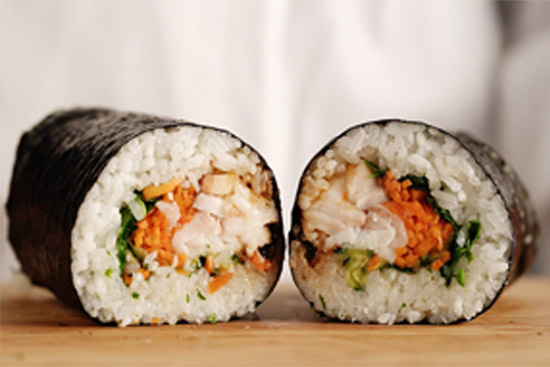
Serves: 5
Preparation time:30 minutes
Cooking time:30 minutes
Sushi Rice 4 cups Sushi Rice
5 cups Cool Water
6 tablespoons Seasoned Rice Vinegar
3 tablespoons White Sugar
1/2 tablespoon sea salt
Miso Marinade
6 ounces White Miso Paste
4 ounces White Sugar
2 ounce Mirin
1 ounces low Sodium Soy Sauce
1 ounce Fresh Ginger, minced
Oven-Roasted Sweet Miso Cod
Miso Marinade, As Needed
6 Black Code Fillets, 4 to 5 ounces each
Tsukemono Salad
1/2 cup seasoned Rice Vinegar
1/4 cup sugar
1 tbsp Sea Salt
1/4 cup ginger Shoots
1 cup carrots, julienne
1 cup cucumber, cut into circles
Nori Sheets, As Needed
Japanese Mustard Greens (Mizuna), As Needed
Sushi Rice:
Rinse and drain rice in a colander until water runs clear. Combine rinsed rice and cool water in a saucepot. Turn heat to medium high and bring water to a simmer. Turn heat to low, cover and continue cooking another 15 to 20 minutes, or until rice is tender and water is absorbed. Remove the pot from the burner, and keep covered, to allow rice to cool for 15 minutes. Turn rice out of pot into a large bowl and gently fluff with a rice spoon to separate the grains. Add vinegar, sugar and salt, and continue fluffing until well blended. Allow rice to cool.
Miso Marinade:
Combine all ingredients in a mixing bowl and whisk to combine.
Oven-Roasted Sweet Miso Cod:
Preheat the oven to 400°F. Heat a grill pan with oil. Grill the cod, skin side up for 3 minutes, or until golden brown. Turn the cod over and brush liberally with miso marinade. Place cod in oven and roast until just opaque throughout. Broil cod with a culinary torch or in a salamander to caramelize.
Tsukemono Salad:
Combine vinegar, sugar and salt in a medium size saucepan. Heat slowly to melt sugar and salt until dissolved. Combine vegetables in a stainless steel or glass bowl and pour hot vinegar mixture over vegetables. Toss to combine and let sit for 5 minutes. Strain off vinegar mixture and save for another use.
Sushi Burritos:
Using a culinary torch or a salamander, toast nori sheets on one side only to make nori crispy.
Place a sheet of toasted nori on a flat work space, shiny-side down. Moisten one end and place a second sheet of toasted nori on moistened edge, overlapping sheets by about an inch, so they are end-to-end, forming a long rectangle. Press sushi rice onto nori sheet as you would any sushi roll. Leave 1 inch of nori uncovered on end closest to you. Leave 6 inches of nori uncovered on the opposite end.
Arrange Tsukemono salad on top of rice and pile a generous amount of Japanese mustard greens on top. . Gently break apart miso cod fillet into bite-size pieces and arrange crosswise on rice on the end closest to you. Roll sushi burrito as you would a regular hand roll, taking care to make the burrito tight and compact. Cut the roll in half crosswise for serving.
Serving Suggestion: Mix together wasabi paste and sour cream with Ponzu Citrus Seasoned Dressing & Sauce to taste for a dipping sauce.
Rinse and drain rice in a colander until water runs clear. Combine rinsed rice and cool water in a saucepot. Turn heat to medium high and bring water to a simmer. Turn heat to low, cover and continue cooking another 15 to 20 minutes, or until rice is tender and water is absorbed. Remove the pot from the burner, and keep covered, to allow rice to cool for 15 minutes. Turn rice out of pot into a large bowl and gently fluff with a rice spoon to separate the grains. Add vinegar, sugar and salt, and continue fluffing until well blended. Allow rice to cool.
Miso Marinade:
Combine all ingredients in a mixing bowl and whisk to combine.
Oven-Roasted Sweet Miso Cod:
Preheat the oven to 400°F. Heat a grill pan with oil. Grill the cod, skin side up for 3 minutes, or until golden brown. Turn the cod over and brush liberally with miso marinade. Place cod in oven and roast until just opaque throughout. Broil cod with a culinary torch or in a salamander to caramelize.
Tsukemono Salad:
Combine vinegar, sugar and salt in a medium size saucepan. Heat slowly to melt sugar and salt until dissolved. Combine vegetables in a stainless steel or glass bowl and pour hot vinegar mixture over vegetables. Toss to combine and let sit for 5 minutes. Strain off vinegar mixture and save for another use.
Sushi Burritos:
Using a culinary torch or a salamander, toast nori sheets on one side only to make nori crispy.
Place a sheet of toasted nori on a flat work space, shiny-side down. Moisten one end and place a second sheet of toasted nori on moistened edge, overlapping sheets by about an inch, so they are end-to-end, forming a long rectangle. Press sushi rice onto nori sheet as you would any sushi roll. Leave 1 inch of nori uncovered on end closest to you. Leave 6 inches of nori uncovered on the opposite end.
Arrange Tsukemono salad on top of rice and pile a generous amount of Japanese mustard greens on top. . Gently break apart miso cod fillet into bite-size pieces and arrange crosswise on rice on the end closest to you. Roll sushi burrito as you would a regular hand roll, taking care to make the burrito tight and compact. Cut the roll in half crosswise for serving.
Serving Suggestion: Mix together wasabi paste and sour cream with Ponzu Citrus Seasoned Dressing & Sauce to taste for a dipping sauce.
Main Crispy fried tofu katsu style 
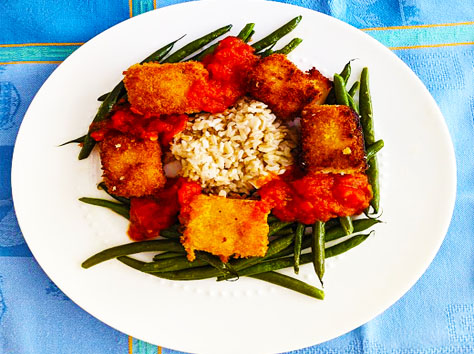
In Japan, Katsu (カツ) basically refers to meat or tofu that has been encrusted in panko breadcrumbs and then deep-fried.
Serves: 4
2 tablespoons low salt soy sauce
2 cups vegetable oil
1/3 cup all-purpose flour to dredge the tofu
2 tablespoons all-purpose flour for the batter
2 tablespoons cornstarch
1/3 cup water
1 cup panko breadcrumbs
optionals
Serve witn Tomato sauce, green beans, cooked brown rice.
Serves: 4
Preparation time:40 minutes
Cooking time:20 minutes
1 (14 oz) block firm or extra-firm tofu2 tablespoons low salt soy sauce
2 cups vegetable oil
1/3 cup all-purpose flour to dredge the tofu
2 tablespoons all-purpose flour for the batter
2 tablespoons cornstarch
1/3 cup water
1 cup panko breadcrumbs
optionals
Serve witn Tomato sauce, green beans, cooked brown rice.
Drain the tofu and Cut into roughly 1-inch slices. Marinate in the soy sauce to cover and blend.
Whisk together 2 tablespoons all-purpose flour, 2 tablespoon cornstarch, and 1/3 cup water to form a very thin batter.
Dredge each tofu cutlet in flour. Shake off excess. Then dip in the flour and cornstarch mixture.
Allow excess to drip off. then, coat with the panko crumbs.
Fry the Tofu
Heat about 1/2 – 1" of vegetable oil to about 375°F in a heavy-bottomed skillet or pot.
Place the breaded tofu cutlets in several batches (about 4 or 5 at the time) in the preheated oil and fry until deep golden brown.
Transfer the tofu to a paper towel lined plate. Sprinkle with salt to finish.
Whisk together 2 tablespoons all-purpose flour, 2 tablespoon cornstarch, and 1/3 cup water to form a very thin batter.
Dredge each tofu cutlet in flour. Shake off excess. Then dip in the flour and cornstarch mixture.
Allow excess to drip off. then, coat with the panko crumbs.
Fry the Tofu
Heat about 1/2 – 1" of vegetable oil to about 375°F in a heavy-bottomed skillet or pot.
Place the breaded tofu cutlets in several batches (about 4 or 5 at the time) in the preheated oil and fry until deep golden brown.
Transfer the tofu to a paper towel lined plate. Sprinkle with salt to finish.
Main Crispy tofu tacos 

The key step is to drizzle the tofu with a combination of olive oil and tomato paste toward the end of cooking, which crisps the edges and lends a deep umami flavor, so much so that this tofu could almost be mistaken for seasoned ground beef.
The tofu comes out so crispy. Even meat eaters said it was superb.
Serves: 2
¼ cup plus 3 tablespoons olive oil, divided
2 tablespoons soy sauce, divided
1 teaspoons ground cumin
1 teaspoon smoked paprika
¼ teaspoon ground cayenne
salt and black pepper
1/4 cup tomato paste
2 small ripe avocados
1 tablespoon mayonnaise
3 tablespoons lime juice
4 flour or corn tortillas, warmed
2 minced green onion, thinly sliced
Serves: 2
Preparation time:15 minutes
Cooking time:40 minutes
1(14- to 16-ounce) blocks firm tofu¼ cup plus 3 tablespoons olive oil, divided
2 tablespoons soy sauce, divided
1 teaspoons ground cumin
1 teaspoon smoked paprika
¼ teaspoon ground cayenne
salt and black pepper
1/4 cup tomato paste
2 small ripe avocados
1 tablespoon mayonnaise
3 tablespoons lime juice
4 flour or corn tortillas, warmed
2 minced green onion, thinly sliced
Step 1
Heat the oven to 400 degrees.
Step 2
Prepare the tofu: Drain it, squeezing out any excess moisture over the sink (your tofu may break into chunks). Coarsely grate the drained tofu onto 1 large (11-by-17-inch), foil-lined sheet pans.Drizzle the tofu with 2 tablespoons olive oil and 1 tablespoon soy sauce.
In a small bowl, mix the cumin, cayenne, 1/2 teaspoon salt and 1/2 teaspoon pepper; sprinkle seasonings over pan and toss to coat. Spread the mixture in an even layer.
Step 3
Roast the tofu, stirring halfway through and rotating the pan, until the tofu sizzles, darkens and crisps, 20 to 30 minutes.
Step 4
In a small bowl, mix together the tomato paste with the remaining 3 tablespoons oil. Drizzle the mixture over the tofu, then toss to combine, spread into an even layer and roast again until the tofu audibly crackles and develops a slight crunch, 10 to 15 minutes.
Step 5
While the tofu roasts, prepare the avocado cream: In a small food processor (or blender), blend the avocados, mayo, lime juice until creamy; season with salt.
Step 6
Swipe the warmed tortillas with the avocado cream, then top with tofu mixture with green onion Serve immediately.
Heat the oven to 400 degrees.
Step 2
Prepare the tofu: Drain it, squeezing out any excess moisture over the sink (your tofu may break into chunks). Coarsely grate the drained tofu onto 1 large (11-by-17-inch), foil-lined sheet pans.Drizzle the tofu with 2 tablespoons olive oil and 1 tablespoon soy sauce.
In a small bowl, mix the cumin, cayenne, 1/2 teaspoon salt and 1/2 teaspoon pepper; sprinkle seasonings over pan and toss to coat. Spread the mixture in an even layer.
Step 3
Roast the tofu, stirring halfway through and rotating the pan, until the tofu sizzles, darkens and crisps, 20 to 30 minutes.
Step 4
In a small bowl, mix together the tomato paste with the remaining 3 tablespoons oil. Drizzle the mixture over the tofu, then toss to combine, spread into an even layer and roast again until the tofu audibly crackles and develops a slight crunch, 10 to 15 minutes.
Step 5
While the tofu roasts, prepare the avocado cream: In a small food processor (or blender), blend the avocados, mayo, lime juice until creamy; season with salt.
Step 6
Swipe the warmed tortillas with the avocado cream, then top with tofu mixture with green onion Serve immediately.
Main Oriental salmon rice muffins 
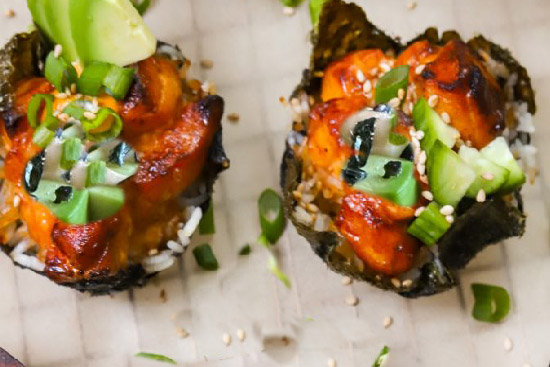
Kewpie mayonnaise is made of egg yolks, canola oil, salt, vinegar, and seasonings. This small ingredient list keeps the flavor pure. Unlike most store-bought mayonnaise, there is no sugar in the product
A substitute for kewpie mayo can be your favorite brand of mayonnaise, your home-made Kewpie-style, or use avocado mayo.
Serves: 6
4 1½ cups cooked sushi rice or basmati rice, cooled
Salmon:
1 lb salmon, skin removed + cubed small
2 tbs sesame oil (or olive oil)
1 tbs low sodium soy sauce
1 tbs honey
2 scallions, diced
1/2 tsp each garlic powder, onion powder, chili powder, paprika
salt to taste
Spicy Mayo:
1/4 cup kewpie mayo or home-made matonnaise
2 tsp Sriracha sauce
1 tsp honey
Toppings:
1/2 avocado, diced small
2 tsp black sesame seeds
Other options: Sciced scallions, shredded carrots
Serves: 6
Preparation time:15 minutes
Cooking time:15 minutes
3 sheets nori paper4 1½ cups cooked sushi rice or basmati rice, cooled
Salmon:
1 lb salmon, skin removed + cubed small
2 tbs sesame oil (or olive oil)
1 tbs low sodium soy sauce
1 tbs honey
2 scallions, diced
1/2 tsp each garlic powder, onion powder, chili powder, paprika
salt to taste
Spicy Mayo:
1/4 cup kewpie mayo or home-made matonnaise
2 tsp Sriracha sauce
1 tsp honey
Toppings:
1/2 avocado, diced small
2 tsp black sesame seeds
Other options: Sciced scallions, shredded carrots
Preheat your oven to 400°F. Grab a scissor and cut your nori sheets into four equal squares.
Toss your cubed salmon in a bowl with all of the rest of the salmon ingredients and coat. Marinate for up to 4 hours.
To each nori square, add about 1 heaping tablespoon of rice and spread out slightly. Transfer the square to your muffin slot, pushing down gently to center the rice in the middle with the edges coming up along the sides of the slot. Grab out 4-5 salmon cubes and fill each muffin slot. Transfer the pan to your oven and bake for 15-17 minutes. Broil, if needed, at the end, to get a little tan on the salmon .. 1-2 minutes.
Remove from heat and allow to cool slightly and top with avocado, sesame seeds and drizzle of spicy mayo.
Toss your cubed salmon in a bowl with all of the rest of the salmon ingredients and coat. Marinate for up to 4 hours.
To each nori square, add about 1 heaping tablespoon of rice and spread out slightly. Transfer the square to your muffin slot, pushing down gently to center the rice in the middle with the edges coming up along the sides of the slot. Grab out 4-5 salmon cubes and fill each muffin slot. Transfer the pan to your oven and bake for 15-17 minutes. Broil, if needed, at the end, to get a little tan on the salmon .. 1-2 minutes.
Remove from heat and allow to cool slightly and top with avocado, sesame seeds and drizzle of spicy mayo.
Main Panko-crusted salmon 
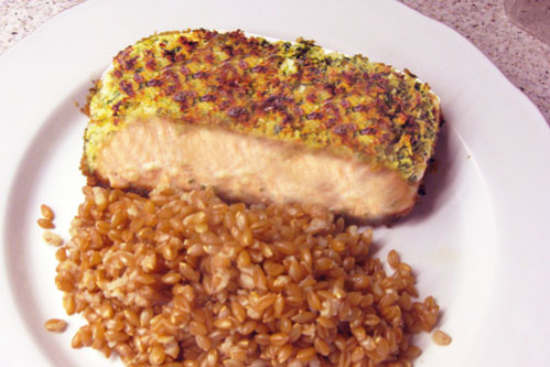
Serves: 4
Preparation time: 15 minutes
Cooking time:10 minutes
2/3 cup panko (Japanese dried bread flakes)2 tablespoons minced fresh parsley
1 teaspoon grated lemon zest
Kosher salt and freshly ground black pepper
2 tablespoons good olive oil
4 (6- to 8-ounce) salmon fillets, skin on
2 tablespoons Dijon mustard
2 tablespoons vegetable oil
Lemon wedges, for serving
Preheat the oven to 425 degrees.
In a small bowl, mix together the panko, parsley, lemon zest, 1/2 teaspoon salt, and 1/2 teaspoon pepper. Drizzle with the olive oil and stir until the crumbs are evenly coated. Set aside.
Place the salmon fillets, skin side down, on a board. Generously brush the top of the fillets with mustard and then sprinkle generously with salt and pepper. Press the panko mixture thickly on top of the mustard on each salmon fillet. The mustard will help the panko adhere.
Heat the vegetable oil over medium-high heat in a 12-inch cast-iron skillet or large heavy, ovenproof pan. When the oil is very hot, add the salmon fillets, skin side down, and sear for 3 to 4 minutes, without turning, to brown the skin.
Transfer the pan to the hot oven for 5 to 7 minutes until the salmon is almost cooked and the panko is browned. Remove from the oven, cover with aluminum foil, and allow to rest for 5 to 10 minutes. Serve the salmon hot or at room temperature with lemon wedges.
In a small bowl, mix together the panko, parsley, lemon zest, 1/2 teaspoon salt, and 1/2 teaspoon pepper. Drizzle with the olive oil and stir until the crumbs are evenly coated. Set aside.
Place the salmon fillets, skin side down, on a board. Generously brush the top of the fillets with mustard and then sprinkle generously with salt and pepper. Press the panko mixture thickly on top of the mustard on each salmon fillet. The mustard will help the panko adhere.
Heat the vegetable oil over medium-high heat in a 12-inch cast-iron skillet or large heavy, ovenproof pan. When the oil is very hot, add the salmon fillets, skin side down, and sear for 3 to 4 minutes, without turning, to brown the skin.
Transfer the pan to the hot oven for 5 to 7 minutes until the salmon is almost cooked and the panko is browned. Remove from the oven, cover with aluminum foil, and allow to rest for 5 to 10 minutes. Serve the salmon hot or at room temperature with lemon wedges.
Main Ramen burger 
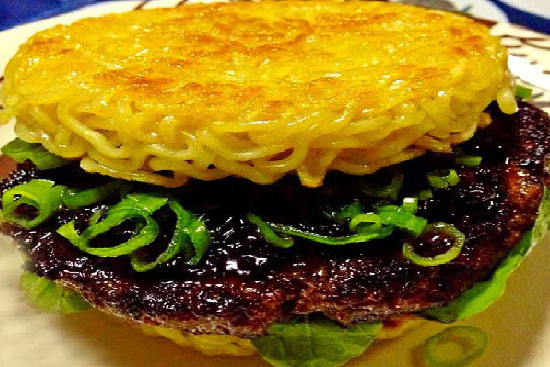
Sriracha is a type of hot sauce available in Asian food markets. It is made from a paste of chili peppers, distilled vinegar, garlic, sugar, and salt. It is named after the coastal city of Si Racha, in the in the Chonburi Province of Eastern Thailand, where it was possibly first produced for dishes served at local seafood restaurants. From wikipedia.org
To shape the ramen into a bun, use ramekins that are similar in size to the burger patty. If you don't have ramekins, substitute pint-size deli containers.
Serves: 1
1 egg
2 tablespoons neutral oil, such as canola or grapeseed
1 tablespoon ketchup
1/2 tablespoon sriracha
1 beef burger patty
Soy sauce
Sesame oil
1 slice American cheese
1 scallion, thinly sliced on the bias
1/2 cup arugula
To shape the ramen into a bun, use ramekins that are similar in size to the burger patty. If you don't have ramekins, substitute pint-size deli containers.
Serves: 1
Preparation time: 30 minutes
Cooking time:15 minutes
1 package ramen noodles1 egg
2 tablespoons neutral oil, such as canola or grapeseed
1 tablespoon ketchup
1/2 tablespoon sriracha
1 beef burger patty
Soy sauce
Sesame oil
1 slice American cheese
1 scallion, thinly sliced on the bias
1/2 cup arugula
Cook the ramen according to the directions on the package (including the seasoning), then drain off the liquid. Let cool to room temperature. In a small mixing bowl, whisk 1 egg until no streaks of yolk remain. Add the ramen, tossing thoroughly to coat with the egg. Divide the egg-dressed ramen into two portions, and place each half into a ramekin.
Cover the ramen with plastic wrap, and weigh it down with a can of soup to compress it into a bun shape. Refrigerate for at least 15 minutes.
Add the oil to a skillet, and set over medium-high heat. Once the oil begins to shimmer, unmold the ramen buns into the pan, and cook until the bottom is a dark golden brown. Flip both of the patties, and cook until a dark golden brown on both sides.
Whisk together the sriracha and ketchup in a small bowl.
Season the hamburger patty with salt, pepper, a splash of soy sauce, and sesame oil. Wipe out the skillet, and cook the burger over medium-high heat until medium rare, or to your preferred degree of doneness. Finish with a splash of soy sauce and sesame oil. Top with a slice of cheese.
Assemble the burger in this order: ramen bun, arugula, ketchup, burger patty (cheese side up), scallions, and the second ramen bun. Wrap in wax paper for easier eating, and serve hot.
Cover the ramen with plastic wrap, and weigh it down with a can of soup to compress it into a bun shape. Refrigerate for at least 15 minutes.
Add the oil to a skillet, and set over medium-high heat. Once the oil begins to shimmer, unmold the ramen buns into the pan, and cook until the bottom is a dark golden brown. Flip both of the patties, and cook until a dark golden brown on both sides.
Whisk together the sriracha and ketchup in a small bowl.
Season the hamburger patty with salt, pepper, a splash of soy sauce, and sesame oil. Wipe out the skillet, and cook the burger over medium-high heat until medium rare, or to your preferred degree of doneness. Finish with a splash of soy sauce and sesame oil. Top with a slice of cheese.
Assemble the burger in this order: ramen bun, arugula, ketchup, burger patty (cheese side up), scallions, and the second ramen bun. Wrap in wax paper for easier eating, and serve hot.
Main Sesame tofu fingers 

Serves: 4
Preparation time:20 minutes
Cooking time:12 minutes
Tofu Fingers:1 Block (15oz.) extra firm tofu, pressed
1 Tablespoon soy sauce
2 Teaspoons rice wine vinegar
1 Teaspoon agave syrup
1/2 Teaspoon sriracha
1/4 Cup cornstarch
Sesame Sauce:
1/4 Cup soy sauce
1/4 Cup tomato sauce
3 Tablespoons agave syrup
1 Teaspoon sriracha
1/2 Teaspoon rice wine vinegar
1 Tablespoon sesame seeds
1 Teaspoon cornstarch
1 Teaspoon water
Press the block of tofu to get as much liquid out of the tofu as possible.
Cut the block of tofu into "fingers".
In a large bowl, whisk together the 1 tablespoon of soy sauce, the 2 teaspoons of rice wine vinegar, the 1 teaspoon of agave, and 1/2 teaspoon of sriracha.
Add the tofu fingers to the bowl with the marinade and toss to coat all of the tofu for about 15-20 minutes.
Add the tofu fingers to a large 'ziploc' bag, and sprinkle the cornstarch into the bag. Seal the bag and toss the tofu. Coat all of the fingers in the cornstarch.
Heat a cast-iron or non-stick frying over medium heat. Cover the bottom of pan with a film oh cooking oil. Brown the tofu one both sides.
Make the sesame sauce:
In a small sauce pan, whisk together the soy sauce, tomato sauce, agave, sriracha, rice wine vinegar and sesame seeds.
Heat on medium low, bring to a simmer, reduce heat to low and simmer for about 5 minutes.
Whisk together the cornstarch and water in a small bowl. Then add that to the sauce, whisk to combine.
Continue to simmer the sauce until it is thick.
When the tofu fingers are brown and crispy, add them to a bowl and pour the sauce over them. Toss to coat and serve
Cut the block of tofu into "fingers".
In a large bowl, whisk together the 1 tablespoon of soy sauce, the 2 teaspoons of rice wine vinegar, the 1 teaspoon of agave, and 1/2 teaspoon of sriracha.
Add the tofu fingers to the bowl with the marinade and toss to coat all of the tofu for about 15-20 minutes.
Add the tofu fingers to a large 'ziploc' bag, and sprinkle the cornstarch into the bag. Seal the bag and toss the tofu. Coat all of the fingers in the cornstarch.
Heat a cast-iron or non-stick frying over medium heat. Cover the bottom of pan with a film oh cooking oil. Brown the tofu one both sides.
Make the sesame sauce:
In a small sauce pan, whisk together the soy sauce, tomato sauce, agave, sriracha, rice wine vinegar and sesame seeds.
Heat on medium low, bring to a simmer, reduce heat to low and simmer for about 5 minutes.
Whisk together the cornstarch and water in a small bowl. Then add that to the sauce, whisk to combine.
Continue to simmer the sauce until it is thick.
When the tofu fingers are brown and crispy, add them to a bowl and pour the sauce over them. Toss to coat and serve
Main Spicy edamame burgers 

They freeze well.
Serve as mini cakes as hors d'oeuvre, appetizers or main meal.
Serves: 10
1 ½ cups cooked chickpeas or 1 15-oz. can chickpeas, rinsed and drained
4 ounces (110 g) sliced mushrooms, shiatake or crimini
1/3 cup water
4 garlic cloves, peeled
1/2 teaspoon ground cumin
1 teaspoon low salt soy sauce
Salt and pepper, to taste
1/2 teaspoon red pepper flakes
1 tablespoon chickpea flour or cornstarch
Oil, for frying
Serves: 10
Preparation time: 20 minutes
Cooking time:10 minutes
1 lb shelled edamame thawed or fresh1 ½ cups cooked chickpeas or 1 15-oz. can chickpeas, rinsed and drained
4 ounces (110 g) sliced mushrooms, shiatake or crimini
1/3 cup water
4 garlic cloves, peeled
1/2 teaspoon ground cumin
1 teaspoon low salt soy sauce
Salt and pepper, to taste
1/2 teaspoon red pepper flakes
1 tablespoon chickpea flour or cornstarch
Oil, for frying
Combine the edamame, chickpeas, mushrooms, water, garlic, cumin, soy sauce and salt and pepper in a food processor and process until smooth. Transfer into a large bowl.
Add the flour and mix well
Place the bowl in the refrigerator for 20 to 30 minutes to make it easier to handle when forming the patties.
Shape mixture into 10 patties.Dust both sides of the patties with chickpea flour or cornstarch.
Heat the oil in a sauté pan and fry the patties for 4 to 5 minutes on each sides, or until golden brown on both sides.
Serve on top of a spinach sald, or on a toasted bun.
Add the flour and mix well
Place the bowl in the refrigerator for 20 to 30 minutes to make it easier to handle when forming the patties.
Shape mixture into 10 patties.Dust both sides of the patties with chickpea flour or cornstarch.
Heat the oil in a sauté pan and fry the patties for 4 to 5 minutes on each sides, or until golden brown on both sides.
Serve on top of a spinach sald, or on a toasted bun.
Main Teriyaki tofu burger 
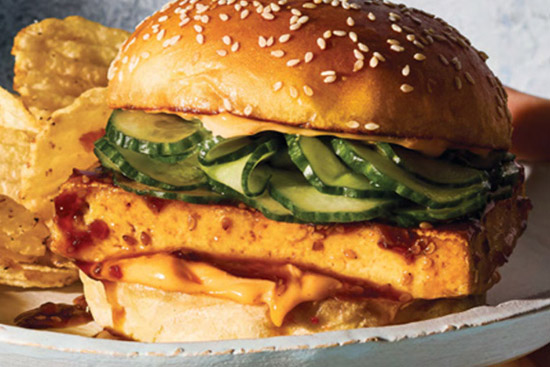
A thick slab of tofu is pan-fried, basted in salty-sweet teriyaki sauce and served on a toasted bun with cured cukes and spicy mayo. It’s a gloriously messy veggie burger, perfect for people who eschew faux meat. Available at most Asian supermarkets, superior Kikkoman Takumi Original Teriyaki Sauce is worth seeking out.
Serves: 1
Salt and sugar to taste
4 tsp (20 mL) mayonnaise
Hot sauce, preferably sriracha, to taste
1 block (397 g) firm tofu
1 1/2 tsp (7 mL) canola oil
2 tbsp (30 mL) teriyaki sauce
1 large burger bun, split
Serves: 1
Preparation time:20 minutes
Cooking time:12 minutes
2-inch (5-cm) piece English cucumber, cut into thin roundsSalt and sugar to taste
4 tsp (20 mL) mayonnaise
Hot sauce, preferably sriracha, to taste
1 block (397 g) firm tofu
1 1/2 tsp (7 mL) canola oil
2 tbsp (30 mL) teriyaki sauce
1 large burger bun, split
1. Place cucumber in a small bowl. Season generously with salt and lightly with sugar. Mix well with your fingertips. Set aside. In a ramekin, mix mayo and hot sauce. Set aside.
2. Cut tofu in half through middle so you have two thick burger-like slabs. (Save one slab for another use.) Press tofu firmly between paper towel to extract as much moisture as possible. Season both sides with salt.
3. Heat oil in a small, nonstick frying pan over medium-high heat. Add tofu. Cook until nicely browned, about 5 minutes per side. Remove from heat and drain off oil. Add teriyaki sauce. Turn and baste tofu off heat until well coated.
4. Toast bun and smear both sides with spicy mayo. Place tofu on bottom bun, top with cucumbers and bun top. Serve immediately.
2. Cut tofu in half through middle so you have two thick burger-like slabs. (Save one slab for another use.) Press tofu firmly between paper towel to extract as much moisture as possible. Season both sides with salt.
3. Heat oil in a small, nonstick frying pan over medium-high heat. Add tofu. Cook until nicely browned, about 5 minutes per side. Remove from heat and drain off oil. Add teriyaki sauce. Turn and baste tofu off heat until well coated.
4. Toast bun and smear both sides with spicy mayo. Place tofu on bottom bun, top with cucumbers and bun top. Serve immediately.
Main Tofu bites 
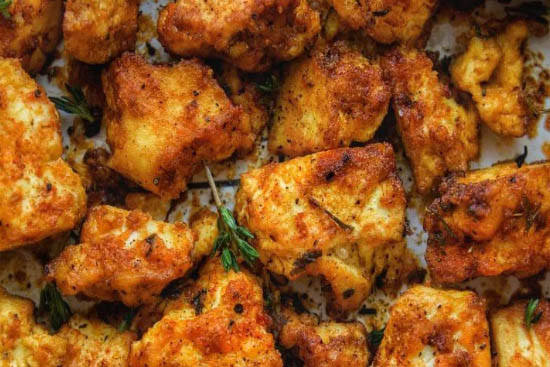
An easy baked tofu recipe that is great on its own or can be used in so many dishes: on salads, in sandwiches, in tacos, on pasta, on nachos, as nuggets, the options are endless, use these everywhere!
The recipe comes from https://itdoesnttastelikechicken.com
Serves: 8
2 tablespoons (30ml) olive oil
2 tablespoons (30ml) soy sauce
1 teaspoon garlic powder
2 blocks (350g each) extra-firm tofu, drained
Serves: 8
Preparation time:10 minutes
Cooking time:30 minutes
1/4 cup (11 g) nutritional yeast2 tablespoons (30ml) olive oil
2 tablespoons (30ml) soy sauce
1 teaspoon garlic powder
2 blocks (350g each) extra-firm tofu, drained
1. OVEN: Preheat your oven to 375F (190C). Line 2 large baking sheet with parchment paper.
AIR-FRYER: Preheat your air-fryer to 350F (180C).
2. In a large bowl, mix together the nutritional yeast, olive oil, soy sauce and garlic powder.
3. Break the block of tofu into small chunks and add them to the bowl. (No need to press the tofu first). Toss the tofu well to evenly coat in the sauce mixture.
4. OVEN: Spread the tofu evenly across the baking sheets and bake for about 30 minutes, stirring halfway through, until lightly golden.
AIR-FRYER: add the tofu to the air-fryer and cook for about 20 minutes, shaking halfway through, until lightly golden.
Serve hot or store in an air-tight container in the fridge, or freeze to use later. Great as main, as nuggets, on salads, in sandwiches, in tacos, on pasta, on nachos, the options are endless, use these everywhere!
AIR-FRYER: Preheat your air-fryer to 350F (180C).
2. In a large bowl, mix together the nutritional yeast, olive oil, soy sauce and garlic powder.
3. Break the block of tofu into small chunks and add them to the bowl. (No need to press the tofu first). Toss the tofu well to evenly coat in the sauce mixture.
4. OVEN: Spread the tofu evenly across the baking sheets and bake for about 30 minutes, stirring halfway through, until lightly golden.
AIR-FRYER: add the tofu to the air-fryer and cook for about 20 minutes, shaking halfway through, until lightly golden.
Serve hot or store in an air-tight container in the fridge, or freeze to use later. Great as main, as nuggets, on salads, in sandwiches, in tacos, on pasta, on nachos, the options are endless, use these everywhere!
Main Tofu patties 
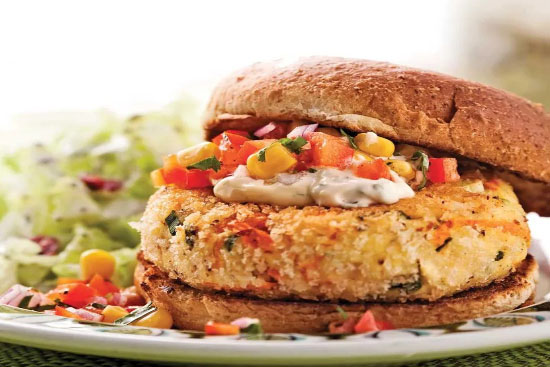
Cooking tips:
❗You may need to press the tofu for 15 minutes to remove excess water.
❗Feel free to add your favourite herbs and spices to the recipe to get your favorite flavour.
❗ For the patties to hold together place patties mixture in to the fridge for 15-30 minutes.
Serves: 4
4oz | 130g | 1 small potato
3tbsp brown rice flour or any flour of your choice
1oz | 40g | 3/4 cup grated carrot
2tbsp chopped green onion
1 garlic clove
Seasonings:
1/4tsp chilli flakes
2oz | 60g | 1 cup breadcrumbs, panko, or chickpea crumbs
salt to taste
Dipping sauce ingredients:
1oz | 30g | 1/2 cup parsley or cilantro
1tbsp lemon juice
4oz | 115g | 1/2 cup vegan mayonnaise
black pepper
Serves: 4
Preparation time:15 minutes
Cooking time:15 minutes
14oz | 400g | 1 block firm tofu4oz | 130g | 1 small potato
3tbsp brown rice flour or any flour of your choice
1oz | 40g | 3/4 cup grated carrot
2tbsp chopped green onion
1 garlic clove
Seasonings:
1/4tsp chilli flakes
2oz | 60g | 1 cup breadcrumbs, panko, or chickpea crumbs
salt to taste
Dipping sauce ingredients:
1oz | 30g | 1/2 cup parsley or cilantro
1tbsp lemon juice
4oz | 115g | 1/2 cup vegan mayonnaise
black pepper
Peel and grate potato.
Mash the block of tofu in a bowl. Add the grated potato, flour, grated carrot, green onion and minced garlic.
Season with salt and chilli flakes.
Add the breadcrumbs. Mix well and set aside while making the dipping sauce.
In a blender, combine parsley, lemon juice and vegan mayonnaise and black peppr. Blend until smooth. Transfer to a bowl.
Shape tofu mixture into 3oz, 70g patties about half inch thick.
Coat patties with breadcrumbs.
Heat a little oil in a non stick skillet. Fry tofu patties 5 to 7 minutes on each side, until golden brown and crispy.
Top with the prepared sauce and enjoy.
Mash the block of tofu in a bowl. Add the grated potato, flour, grated carrot, green onion and minced garlic.
Season with salt and chilli flakes.
Add the breadcrumbs. Mix well and set aside while making the dipping sauce.
In a blender, combine parsley, lemon juice and vegan mayonnaise and black peppr. Blend until smooth. Transfer to a bowl.
Shape tofu mixture into 3oz, 70g patties about half inch thick.
Coat patties with breadcrumbs.
Heat a little oil in a non stick skillet. Fry tofu patties 5 to 7 minutes on each side, until golden brown and crispy.
Top with the prepared sauce and enjoy.
Main Vegan salmon 
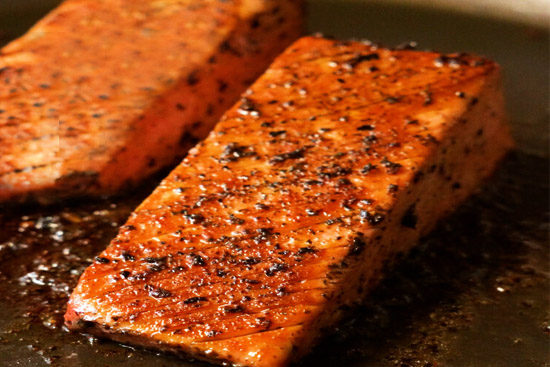
Super Firm Tofu is recommended as it has the best texture and is the easiest to work with.
Serves: 4
Marinade
1 tsp veggie bouillon concentrate
1/4 cup vegan mayo
1 Tbsp miso Paste
1 Tbsp nutritional Yeast
1 tsp dill, dried
1 tsp capers
1 tsp caper brine
1 Tbsp rice vinegar
1/2 tsp garlic powder
1/2 cup beet Juice, from a cook beet)
2 nori sheets
1 tsp MSG or salt to taste
Serves: 4
Preparation time:15 minutes
Cooking time:10 minutes
16 oz Super Firm Tofu *Marinade
1 tsp veggie bouillon concentrate
1/4 cup vegan mayo
1 Tbsp miso Paste
1 Tbsp nutritional Yeast
1 tsp dill, dried
1 tsp capers
1 tsp caper brine
1 Tbsp rice vinegar
1/2 tsp garlic powder
1/2 cup beet Juice, from a cook beet)
2 nori sheets
1 tsp MSG or salt to taste
Cut your block of tofu in half. You can do so at a diagonal, or straight, up to you! Then cut each half into half so you'll have 4 filets.
Next, lightly score each filet on the top and bottom, to create a fishy texture and so they marinate better.
For the marinade, add all the ingredients to a blender or food processor and blend up as fine as possible. Crush up the nori sheets a bit with your hands to make it easier for the blender.
Add the filets to some tupperware or marinade bag and pour over the marinade. You can gently open up the filets to expose the scored sections to the marinade but do so carefully so you don't split them. Let the filets marinade at least 4 hours but overnight is best.
To prepare, heat up a little oil in a pan (preferably non-stick) over medium heat and grill your tofu salmon for 3 - 4 minutes per side. You can either grill all four sides, or just two. Up to you!
Feel free to season it with some blackening seasoning, or a Tartar Sauce like the one on my Filet-O-Fish recipe. Maybe brush some Teriyaki sauce, whatever you like and enjoy!
source of recipe: https://theeburgerdude.com/wprm_print/vegan-salmon
Next, lightly score each filet on the top and bottom, to create a fishy texture and so they marinate better.
For the marinade, add all the ingredients to a blender or food processor and blend up as fine as possible. Crush up the nori sheets a bit with your hands to make it easier for the blender.
Add the filets to some tupperware or marinade bag and pour over the marinade. You can gently open up the filets to expose the scored sections to the marinade but do so carefully so you don't split them. Let the filets marinade at least 4 hours but overnight is best.
To prepare, heat up a little oil in a pan (preferably non-stick) over medium heat and grill your tofu salmon for 3 - 4 minutes per side. You can either grill all four sides, or just two. Up to you!
Feel free to season it with some blackening seasoning, or a Tartar Sauce like the one on my Filet-O-Fish recipe. Maybe brush some Teriyaki sauce, whatever you like and enjoy!
source of recipe: https://theeburgerdude.com/wprm_print/vegan-salmon
Dessert Fried banana wontons with custard sauce 
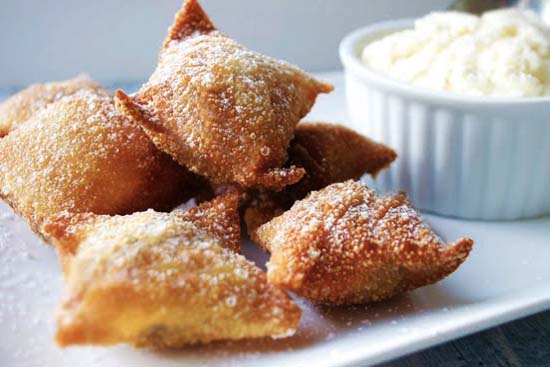
This is a dessert version of classic fried savory ravioli, dressed up with custard sauce.
Serves: 8
1/4 cup golden brown sugar (packed)
1/4 cup graham cracker crumbs
2 tablespoons finely chopped walnuts
2 tablespoons finely chopped pecans
16 wonton wrappers
1 large egg, beaten to blend
vegetable oil (for frying)
Powdered sugar (optional)
Serve with Vanilla Custard Sauce
Serves: 8
Preparation time: 20 minutes
Cooking time:10 minutes
3/4 cup finely chopped peeled ripe bananas 1/4 cup golden brown sugar (packed)
1/4 cup graham cracker crumbs
2 tablespoons finely chopped walnuts
2 tablespoons finely chopped pecans
16 wonton wrappers
1 large egg, beaten to blend
vegetable oil (for frying)
Powdered sugar (optional)
Serve with Vanilla Custard Sauce
Gently mix bananas, brown sugar, graham cracker crumbs, walnuts and pecans in medium bowl (do not mash bananas).
Lay wonton wrappers on work surface and brush edges with egg. Spoon 1 1/2 heaping teaspoons banana filling into center of each wrapper.
Fold wrappers diagonally over filling. Press edges to seal. Place on baking sheet lined with plastic wrap. (Ravioli can be prepared 6 hours ahead.
Cover with plastic and refrigerate.) Add enough oil to heavy large skillet to reach depth of 2 inches.
Heat over medium heat to 350 F. Working in batches, add ravioli; cook until golden brown, about 45 seconds per side.
Using slotted spoon, transfer to paper towels; drain.
Arrange ravioli on serving plate and dust with powdered sugar, if desired. Serve with Vanilla Custard Sauce.
Lay wonton wrappers on work surface and brush edges with egg. Spoon 1 1/2 heaping teaspoons banana filling into center of each wrapper.
Fold wrappers diagonally over filling. Press edges to seal. Place on baking sheet lined with plastic wrap. (Ravioli can be prepared 6 hours ahead.
Cover with plastic and refrigerate.) Add enough oil to heavy large skillet to reach depth of 2 inches.
Heat over medium heat to 350 F. Working in batches, add ravioli; cook until golden brown, about 45 seconds per side.
Using slotted spoon, transfer to paper towels; drain.
Arrange ravioli on serving plate and dust with powdered sugar, if desired. Serve with Vanilla Custard Sauce.
Dessert Kiwi sorbet 
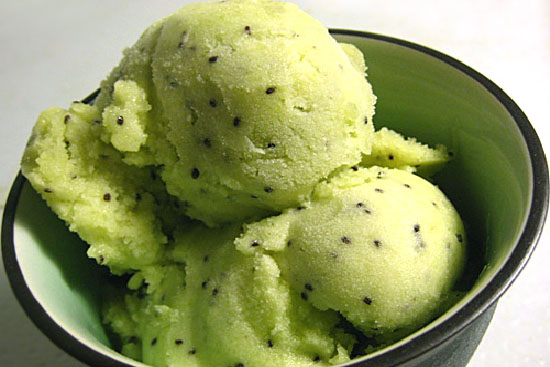
Serves: 8
Preparation time: 45 minutes
Cooking time:10 minutes
8 kiwis 1/2 cup sugar
1/2 cup water
2 tablespoons lemon juice
Peel kiwis. Puree in a food processor. Combine water and sugar. Heat in a saucepan until sugar is dissolved. Cool the syrup. Add the lemon juice and kiwi puree.
Pour the mixture in an ice cream maker and freeze 15 to 20 minutes. Serve with kiwi slices or other color contrasting fruit if desired.
Pour the mixture in an ice cream maker and freeze 15 to 20 minutes. Serve with kiwi slices or other color contrasting fruit if desired.
Dessert Spicy poached peaches 
Serves: 6
1 1/2 cups granulated sugar
2 cinnamon sticks
8 slices peeled ginger, crushed slightly
6 slightly under ripe peaches
1 lemon, halved
Vanilla ice cream or whipped cream (optional)
Preparation time: 30 minutes
Cooking time:30 minutes
3 cups water 1 1/2 cups granulated sugar
2 cinnamon sticks
8 slices peeled ginger, crushed slightly
6 slightly under ripe peaches
1 lemon, halved
Vanilla ice cream or whipped cream (optional)
Combine water, sugar, cinnamon and ginger in a large saucepan. Set over high heat and stir until sugar dissolves. When boiling, reduce heat. Simmer, uncovered, for 10 minutes.
Meanwhile, peel peaches, cut them in half and remove pits. Cut halves in half again. Rub peaches all over with cut lemon.
After sugar-ginger mixture has simmered for 10 minutes, add half of peaches. Reduce heat slightly and simmer gently until just tender, from 4 to 6 minutes.
Then remove with a slotted spoon. Add remaining peaches and repeat cooking as directed above.
When all peaches have been poached, remove ginger from poaching liquid and discard. Bring liquid back to a boil. Boil gently, uncovered, over medium-high heat until reduced to a thick amber syrup, about 10 minutes. Stir often near end of cooking. Remove cinnamon sticks.
Arrange peaches in bowls. Pour warm syrup over fruit. Serve immediately or cover and refrigerate. Just before serving reheat. Serve with ice cream or whipped cream.
Meanwhile, peel peaches, cut them in half and remove pits. Cut halves in half again. Rub peaches all over with cut lemon.
After sugar-ginger mixture has simmered for 10 minutes, add half of peaches. Reduce heat slightly and simmer gently until just tender, from 4 to 6 minutes.
Then remove with a slotted spoon. Add remaining peaches and repeat cooking as directed above.
When all peaches have been poached, remove ginger from poaching liquid and discard. Bring liquid back to a boil. Boil gently, uncovered, over medium-high heat until reduced to a thick amber syrup, about 10 minutes. Stir often near end of cooking. Remove cinnamon sticks.
Arrange peaches in bowls. Pour warm syrup over fruit. Serve immediately or cover and refrigerate. Just before serving reheat. Serve with ice cream or whipped cream.
conversion of liquids
Weights
Temperatures
Measures of non liquid ingredients
Non-liquid ingredients in volume converted
|
|||||||
|---|---|---|---|---|---|---|---|
Ingredient |
1 cup |
3/4 cup |
2/3 cup |
1/2 cup |
1/3 cup |
1/4 cup |
2 tablespoons |
| All-purpose wheat flour | 120 g | 90 g | 80 g | 60 g | 40 g | 30 g | 15 g |
| All-purpose sifted wheat flour | 110 g | 80 g | 70 g | 55 g | 35 g | 27 g | 13 g |
| White sugar | 200 g | 150 g | 130 g | 100 g | 65 g | 50 g | 25 g |
| Powdered sugar/Icing sugar | 100 g | 75 g | 70 g | 50 g | 35 g | 25 g | 13 g |
| Brown sugar normally packed | 180 g | 135 g | 120 g | 90 g | 60 g | 45 g | 23 g |
| Corn flour | 160 g | 120 g | 100 g | 80 g | 50 g | 40 g | 20 g |
| Cornstarch | 120 g | 90 g | 80 g | 60 g | 40 g | 30 g | 15 g |
| Rice (not-cooked) | 190 g | 140 g | 125 g | 95 g | 65 g | 48 g | 24 g |
| Macaroni (uncooked) | 140 g | 100 g | 90 g | 70 g | 45 g | 35 g | 17 g |
| Couscous (uncooked) | 180 g | 135 g | 120 g | 90 g | 60 g | 45 g | 22 g |
| Quick oatmeal (uncooked) | 90 g | 65 g | 60 g | 45 g | 30 g | 22 g | 11 g |
| Table salt | 300 g | 230 g | 200 g | 150 g | 100 g | 75 g | 40 g |
| Butter / Margarine | 240 g | 180 g | 160 g | 120 g | 80 g | 60 g | 30 g |
| Shortening | 190 g | 140 g | 125 g | 95 g | 65 g | 48 g | 24 g |
| Fruits and légumes chopped | 150 g | 110 g | 100 g | 75 g | 50 g | 40 g | 20 g |
| chopped walnuts | 150 g | 110 g | 100 g | 75 g | 50 g | 40 g | 20 g |
| Nuts /ground almonds | 120 g | 90 g | 80 g | 60 g | 40 g | 30 g | 15 g |
| Fresh bread crumbs (not packed) | 60 g | 45 g | 40 g | 30 g | 20 g | 15 g | 8 g |
| Dry bread crumbs | 150 g | 110 g | 100 g | 75 g | 50 g | 40 g | 20 g |
| Parmesan grated | 90 g | 65 g | 60 g | 45 g | 30 g | 22 g | 11 g |
| Chocolate chips | 150 g | 110 g | 100 g | 75 g | 50 g | 38 g | 19 g |


As the sun rises or sets in
JAPAN
"May every sunrise hold more promise, and every sunset hold more peace."
The {Page Turner} E-Cookbooks
Library on a world cooking journey
22 Recipes
7 Appetizers
12 Main dishes
3 Desserts







